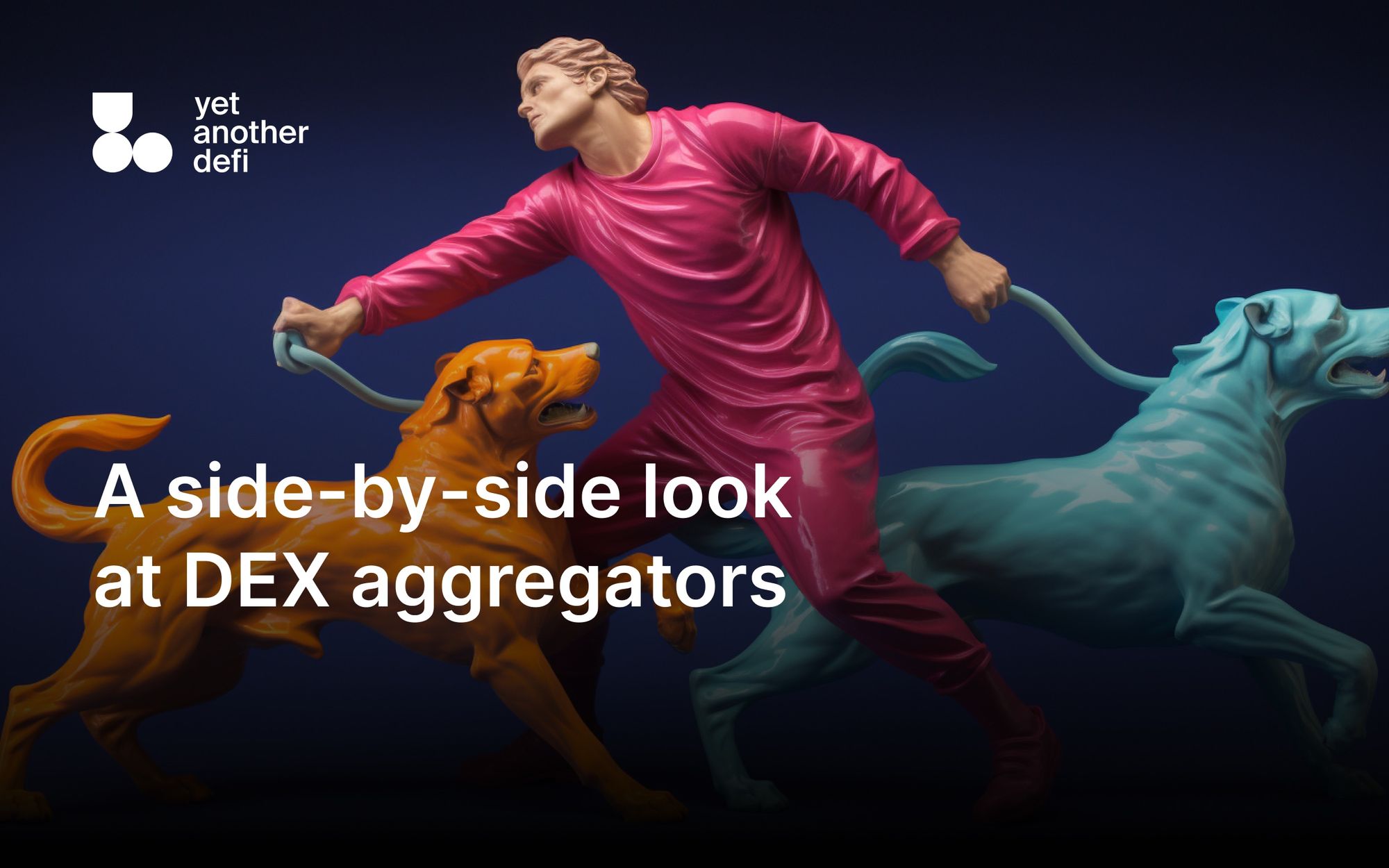DEX aggregators comparison
Although there are numerous DEX aggregators available, they share a common function: routing a single transaction across various liquidity pools to save users gas fees, minimize price impact, and obtain the most optimized rates possible.

For more information, check out our previous articles about what DEX aggregators are and how DEX aggregators work
With the abundance of aggregators available, selecting the one that best suits your needs can be daunting. To compare aggregators effectively, it is necessary to establish a set of comparison criteria.
Routing algorithm
In DEX aggregators, routing algorithms can be classified into two main types: intrachain routing and cross-chain routing.
Intrachain routing, or on-chain routing, involves finding the most optimized path for a trade across existing liquidity pools within a single blockchain. On the other hand, cross-chain routing involves identifying the best swap route from one blockchain to another.
In cross-chain routing algorithms, the router typically creates a path across two different blockchains to identify the most optimized scenario for a trade. To enable such a trade, a specialized technology known as cross-chain bridges is utilized.
Cross-chain bridges often require locking or burning tokens on the source chain using a smart contract, followed by the unlocking or minting of tokens through another smart contract on the destination chain.
Smart contracts
When evaluating DEX aggregators' smart contracts, there are several factors to consider, including whether they have been audited, if they can be verified, and whether the project has smart contracts at all.
An audit entails a comprehensive analysis of a contract's code by a reputable security agency to identify potential security issues, incorrect and inefficient coding, and to suggest solutions to resolve any identified problems. When it comes to source-code verification, verifying that the source code of a smart contract in a high-level language (such as Solidity) compiles to the same bytecode to be executed at the contract address.
Monetization model/fees
There are two primary monetization models utilized by DEX aggregators: the positive-slippage model and the model based on fees generated from swaps.
Positive slippage occurs when the resulting price is better than the price at which the user intended to buy or sell. In this case, the aggregators might want to “keep the change,” taking the positive slippage as profit. However, others may choose to distribute the surplus to their treasury or referral program.
The transaction-fee model involves utilizing the fees generated on the taker side of every swap to fund further development of the aggregator, at least in part. This approach is commonly practiced in the industry.
PMMs and the RFQ system
In theory, any DEX aggregator can access to on-chain or off-chain liquidity. However, compared to on-chain liquidity, which is sourced by sampling smart contract liquidity pools like Uniswap and Curve, off-chain liquidity is sometimes sourced from private market makers (PMMs) — sometimes called professional or proactive market makers.
PMMs have a considerable amount of liquidity to “play with” and are willing to participate in the market dynamics with the aim of reselling these assets on another platform for a profit. As a result, when swapping, you might receive a more competitive quote than one generated solely by an automated market maker (AMM).
To take advantage of the opportunity to earn a profit, PMMs use the request-for-quote (RFQ) system. The RFQ system is aware when investors want to execute a large block trade and invites PMMs to participate.
Tokens
There are a few reasons why comparing DEX aggregators’ tokens can be useful when selecting the right solution. Typically, crypto tokens are an effective means of raising capital for a project. Therefore, if a token is popular and has a high market capitalization, it indicates a high level of trust in the project, which is a positive sign. Moreover, token stakers are often rewarded when making swaps — for example, with a gas refund. PMMs partnering with 1inch prioritize your transaction if you are staking the 1inch token.
DAO
When a project’s pool of funds is crowdsourced, it’s important to transfer decision-making power to the investors. One of the ways to achieve this is through a decentralized autonomous organization, or DAO, which is an emerging legal structure without a central governing body, where members share a common goal to act in the entity's best interest, Utilizing a DAO shifts power to those who have provided funding to the project, promoting transparency and decentralization as essential pillars of the infrastructure.
Open source
As DeFi is primarily a community of libertarian-minded developers, it is crucial to acknowledge that open-source code is a common courtesy in this space. It ensures the transparency of all processes and serves as a means to verify the technology, as seen in the case of smart contracts (see above).
***
Here is a cheat sheet for you to keep on hand whenever you ned to make a swap. The table below lists the most popular DEX aggregators, along with relevant trading criteria that can be useful in making profitable trades.
| Protocol | Yad | 1inch | Matcha / 0x | ParaSwap | Transferto.xyz / Li.Fi | Rubic | Rango |
|---|---|---|---|---|---|---|---|
| Stats | Dashboard | Dashboard | Dashboard | ||||
| Blockchains | 6 | 10 | 8 | 7 | 16 | 26 | 46 |
| Liquidity sources | 150 | 228 | 37 | 75 | 28 | 60+ | 30 |
| Tokens | 3,500 | 3,500 | 1,000 | ??? | 5,000 | 15,500 | 15,000 |
| Bridges | Coming soon | ❌ | ❌ | ❌ | 13 | 30 | 25 |
| Routing and execution | |||||||
| Intrachain routing algorithm | Yad router | 1Inch Router v5 | 0x Router | Augustus Swapper | 0x 1Inch ParaSwap OpenOcean | 0x 1Inch | 1Inch ParaSwap OpenOcean Jupiter Osmosis |
| Cross-chain routing algorithm | Coming soon | ❌ | ❌ | ❌ | LiFi cross-chain router | LiFi DeBridge Symbiosis Celer | |
| Cross-chain execution | Coming soon | Manual swap | ❌ | ❌ | Automated | Automated | Manual swaps/ automated |
| Smart contracts | YAD transformer smart contracts | Aggregation Router V5 smart contracts | 0x Protocol | Augustus Swapper | LI.FIDiamond (Multi-facet Proxy) | ❌ | Rango V1 smart contracts |
| Liquidity providers | |||||||
| DEX AMM pools | ✔️ | ✔️ | ✔️ | ✔️ | ✔️ | ✔️ | ✔️ |
| RFQ | Coming soon | RFQ feature on Limit Orders | ✔️ | RFQ orders from ParaSwap Pools for direct swaps on 0x V2 and V4 | ❌ | ❌ | ❌ |
| PMMs | Coming soon | ✔️ | ✔️ | ✔️ | ❌ | ❌ | ❌ |
| Governance | |||||||
| Governance model | Centralized | DAO | DAO | DAO | Centralized | Centralized | Centralized |
| Protocol token | ❌ | 1INCH | ZRX | PSP | ❌ | RBC | RANGO |
| Integration | |||||||
| Widget | ✔️ | ✔️ | ❌ | ✔️ | ✔️ | ✔️ | ❌ |
| API | ✔️ | ✔️ | ✔️ | ✔️ | ✔️ | ✔️ | |
| API SDK | ❌ | ❌ | ❌ | ✔️ | ✔️ | ✔️ | ✔️ |
| Open source | ✔️ | ✔️ | ✔️ | ✔️ | ✔️ | ✔️ | ❌ |
| Smart routing | ✔️ | ✔️ | ✔️ | ✔️ | ✔️ | ✔️ | ✔️ |
Are you interested in one of the aggregators but you need more convincing? Here’s a brief overview of the most popular solutions in the market that you may find helpful!
1inch
1inch Network is a DEX aggregator solution that utilizes the so-called Pathfinder algorithm. Pathfinder splits swaps across supported liquidity protocols, uses multiple “market depths” as bridges between source and destination tokens, and migrates tokens from Aave and Compound.
Matcha
To maximize returns on swaps, the 0x API underlying the Matcha DEX aggregator fills across different sources and scans limit orders from the protocol's networked liquidity. To reduce transaction costs, they also utilize meta transactions and gas tokens.
ParaSwap
Paraswap utilizes a proxy smart contract called Augustus to facilitate swaps. Augustus supports three types of swaps: Simple-Path, Multi-Path, and Mega-Path. Simple-Path swaps allow for token swapping without the use of any intermediary tokens. Multi-Path swaps involve the use of one or multiple intermediary tokens in a single swap. Mega-Path swaps can be broken down into multiple Multi-Swaps and are typically useful with larger amounts.
Rubic
Rubic utilized a Multi-Chain Routing Contract to optimize users’ swaps. This contract scrapes liquidity across different blockchains, DEXs, and aggregated bridges. While not revealing how the contract works, Rubic explains the general algorithm of how the transaction gets executed. When a user wants to swap tokens from Blockchain A to Blockchain B, they make a transaction on Blockchain A, which sends tokens to the Multi-Chain Routing smart contract on Blockchain A. Separate validators sign the transaction and forward the message to the relayer.
Rango
Similar to the services mentioned above, the Rango Protocol searches all possible DEXs and bridges for liquidity. It wraps all multi-chain swaps into multiple raw transactions over EVM-based blockchains, Cosmos-compatible networks, or UTXO-based blockchains and determines the best possible route based on user experience, fee amount, and swap output.
LiFi
As a B2B solution, LiFi focuses on dApps decision makers who might want to integrate their SDK and cross-chain bridging and swaps into their product. To explain how their technology works, they say: “In a nutshell, LI.FI is like 1inch & Paraswap for bridges; we choose the best bridge to move funds from one chain to another. Furthermore, since many bridges support a limited amount of tokens, we have DEXs on both sides of the bridges to swap before and after the bridge, thus facilitating any-2-any swaps across chains.”
YAD
YAD, or Yet Another DeFi, aims to bridge the gaps in the DEX aggregator niche through a set of mechanics. It scrapes liquidity information from available sources and proposes the most efficient price for the quote, splits orders between available pools to reduce price impact, and allows users to limit acceptable slippage. Additionally, it scans different market prices and depths to offer the most optimized route possible for users' trades.

